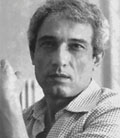
FACES &TRACESNaji S. Al-Ali: The Most Famous Cartoonist in the Middle East [Archives:2007/1074/Culture]
August 6 2007
 |
Naji Salim Al-Ali (1937-1987) was a Palestinian cartoonist and journalist. He was born in Al-Shajara village near Tiberias in Galilee. At the age of 10, Al-Ali emigrated to Ain Al-Helwa, a refugee camp in Southern Lebanon located near Sidon. He attended primary school at the Christian Churches Union's School in Lebanon, after which he departed to Tripoli and obtained a diploma in mechanics and electrical engineering. He had to work as a seasonal farm laborer picking oranges and lemons. He traveled to Saudi Arabia in 1957 to work and stayed there two years. In the early 1960s, Al-Ali returned to Lebanon to continue his studies in drawing and joined the Academy of Arts but he discontinued his studies due to recurring arrests by the Lebanese Intelligence Service and worked instead briefly as a drawing instructor at Al-Jaafriya College in Tyre.
During his stay in the camp, Al-Ali began to express his political views through painting on walls. In 1961, Ghassan Kanafani, the late Palestinian journalist, visited Ain Al-Helwa and saw Al-Ali's cartoons. Kanafani took some of these cartoons, published them in Al-Hurriya, the Arab nationalist magazine, and encouraged Al-Ali to continue his drawings. Al-Ali traveled to Kuwait in 1963 to work as an editor and a reporter for Al-Talee'ah weekly magazine published by the Kuwaiti Progressive Party, after which he worked for Al-Siyasa Kuwaiti newspaper from 1968 to 1975. In 1974, Al-Ali returned to Lebanon to work on the editorial board of the Lebanese newspaper Al-Safir until 1983. During this period he also contributed drawings to Al-Khalij newspaper in the United Arab Emirates. In 1982 during the Israeli invasion of Lebanon, Al-Ali was an eyewitness to the terrifying massacre that happened in the Palestinian refugee camps of Sabra and Shatila. He returned to Kuwait in 1983 and worked for Al-Qabas, a Kuwaiti daily and widespread newspaper and also continued his work with Al-Khalij newspaper. In October 1985, he was expelled from Kuwait due to political reasons and settled down in London continuing his work for Al-Qabas newspaper's London branch.
Al-Ali developed a stark and symbolic style during his 30-year campaign on behalf of Palestine. His life was seamlessly interlaced with the trails of exiled Palestinian and ordinary Arab people. The main characters in Al-Ali's drawings are Handala, Fatima, Al-Rajul Al-Tayyib (The Good Man), and Al-Mutakarrish (The Potbellied Man) and other secondary characters. \”Handala\”” (which means in Arabic a symbol of bitterness) is the most famous of Al-Ali's cartooned characters. He is depicted as a ten-year old boy and appeared for the first time in Al-Siyasa Kuwaiti newspaper in 1969. Handala wears ragged clothes


